Last weekend I had spent half my Saturday at a private range with a friend and his son. It was just the three of us on the range. In addition to some true plinking, we shot the 5×5 drill, did some plate-rack work, and ran an informal competition or two. Toward the end of the day I let the other two guys take a few shots my my 686. When the 14-year old dropped the hammer on his first round, the result was an unimpressive fizzle. It was the first revolver squib load I’ve ever witnessed and my range session came to an abrupt end. But, I definitely learned a couple of things.
Squib Load Safety
The only effective safety precaution for a squib load is realizing that a squib load has been fired. If you recognize this condition, IMMEDIATELY CEASE FIRE! If you are the non-firing party and see or hear a squib load, CALL A CEASE FIRE IMMEDIATELY! Had another round been fired there is a very good chance that one, two, or three people would have suffered injuries. Though I am primarily interested in the revolver squib load, these precautions apply to any firearm.
In this case I was keeping a close eye on my buddy’s kid as he fired a cylinder. I am told that I called a cease fire pretty much immediately, though it my head it seemed like it took several seconds for the thought to be verbalized. How did I recognize it as a squib load?
Sound: The biggest tell-tale for me was the sound. Squibs are often described as a “pop” rather than a bang. I don’t know if I would call it a pop exactly but it was unlike anything else I’ve ever heard. It was noticeable for its softness and it seemed to produce an elongated report. If you hear a report that doesn’t sound right, cease fire!
Recoil: The shooter reported very little recoil. Though I called a cease fire, he said he knew something was wrong and would have stopped shooting anyhow, because of the near total lack of recoil. If you are shooting and experience something that doesn’t feel right, heed your gut and cease fire long enough to check the gun out.
Impact: His dad, who was keeping an eye on the downrange area, reported noticing the lack of any impact. We were firing on a plate rack and obviously no plate was hit. The backstop was a earth berm which usually displays a pretty good visual indicator of misses. If you are watching your buddy shoot and notice a lack of impact along with an odd report, don’t be afraid to call a cease fire.
I can’t stress this enough – if you experience an odd report, reduced recoil, or any other symptoms associated with a squib load, cease fire. Also – and this truly should go without saying – always wear eye protection on the range.
EXAMINING THE Revolver Squib Load
After the shot we opened the gun up and made it safe. I peered down the barrel from the breach and immediately saw unburned powder on the forcing cone. The round in question was a factory .38 Special from Federal’s American Eagle line and the powder is yellowish. I could not see light coming through the barrel.
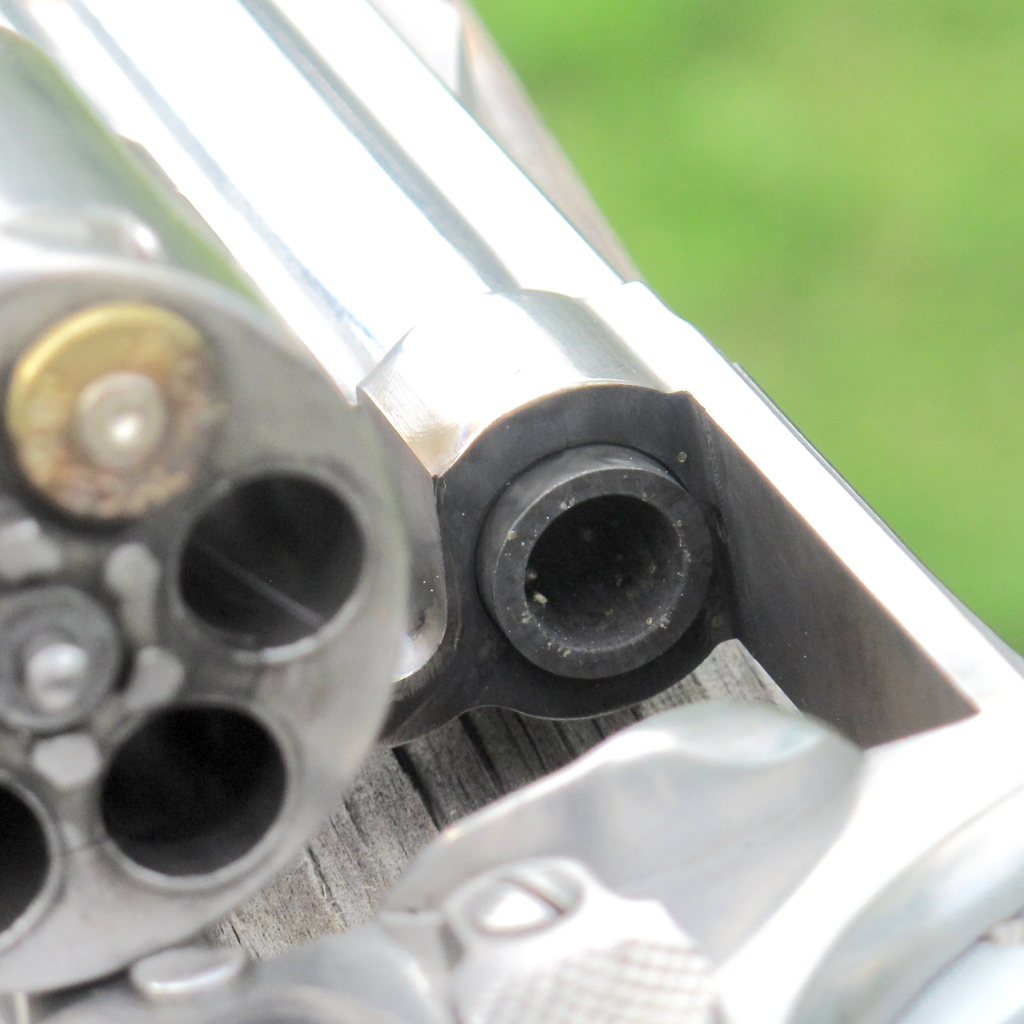
I cleared the gun again and looked down the barrel from the muzzle end. About half an inch from the muzzle I could see the 130-grain round-nose projectile. Looking into the cylinder I saw a lot more unburned powder, as well as a peculiar blast pattern around the face of that chamber.
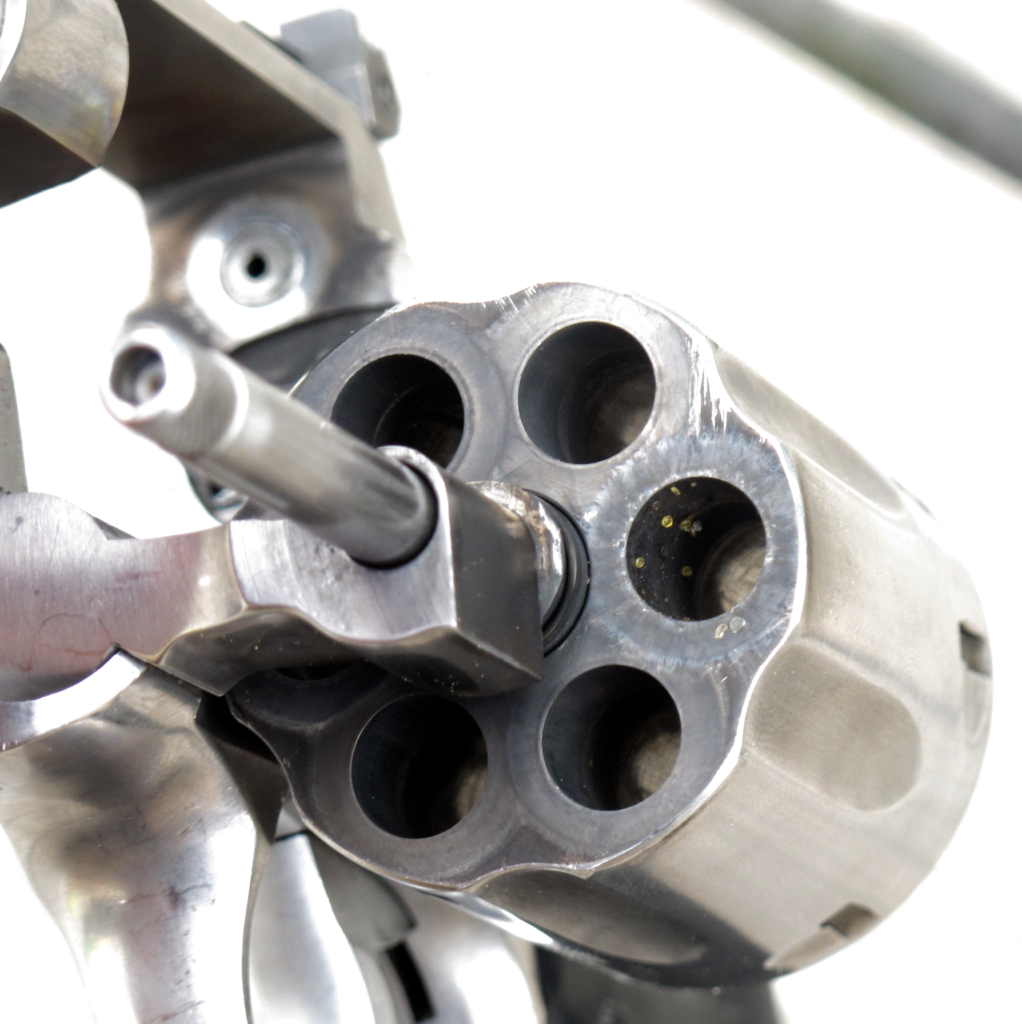
Revolver Squib Load: What Happened?
So what happened to cause my first (and hopefully only) revolver squib load? This was factory ammunition from a major, reputable manufacturer, and obviously there was powder in the case. In this instance I am fairly certain the ammunition had gotten wet at some point. I was cleaning out my bucket of random loose rounds and this was the only one of its kind. The case had a patina that said I probably shouldn’t shoot it but…
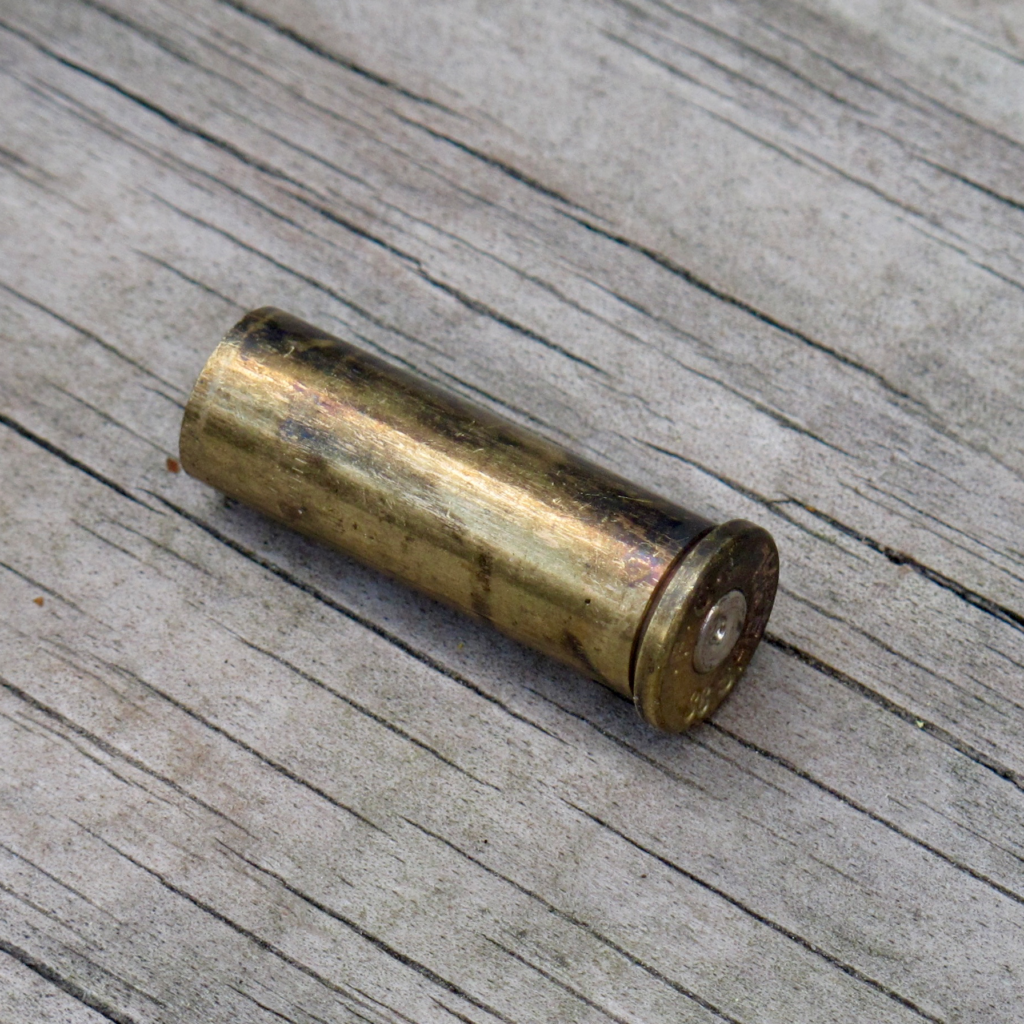
In an instance of pure coincidence, I had already fired a few rounds of my preferred carry load that day to verify function and point of impact. Four of these rounds had been through the washing machine on a Speed Strip that had been left in my back pocket. I was pleased to note that all rounds fired with no noticeable defect or deviation. This is another benefit of premium ammunition: it is well protected from the elements.
Clearing the Revolver Squib Load
After this load put an unexpected early end to my range day, I had to deal with it. I’m sure most of you have an idea of how to fix the problem but I’ll go through it anyway. The basic procedure is to push the bullet back down the barrel. You will need a rod that is rigid enough to accomplish this, but softer than the bore and rifling (wood or brass rods are ideal). Since my gun has a .357 bore diameter, this task called for a 5/16″ (0.3125″) dowel. A 3′ x 5/16″ dowel cost me $.99 (tax included) at Home Depot. This is enough dowel to make 6″ “squib sticks” for you and your five closest friends.
First, cut your dowel rod to size. You want it to be slightly longer than your gun’s barrel, but not too much longer. The longer it is, the more flexible and likely to break it is. I cut mine to around 6″. You will also need a hammer to pound the rod through the bore. If you are using a steel hammer use caution as you get closer to the muzzle. A plastic or rubber mallet is probably the better choice for this job. Once you have the appropriate tools you are ready to begin.
First, open the cylinder and ensure the gun is unloaded. Leave the cylinder open. Invert the gun so that it is pointed muzzle up. Secure it by the grip – in my case I simply squeezed the stocks between my knees. Insert the dowel in to the bore, and pound the rod through with a mallet or hammer.
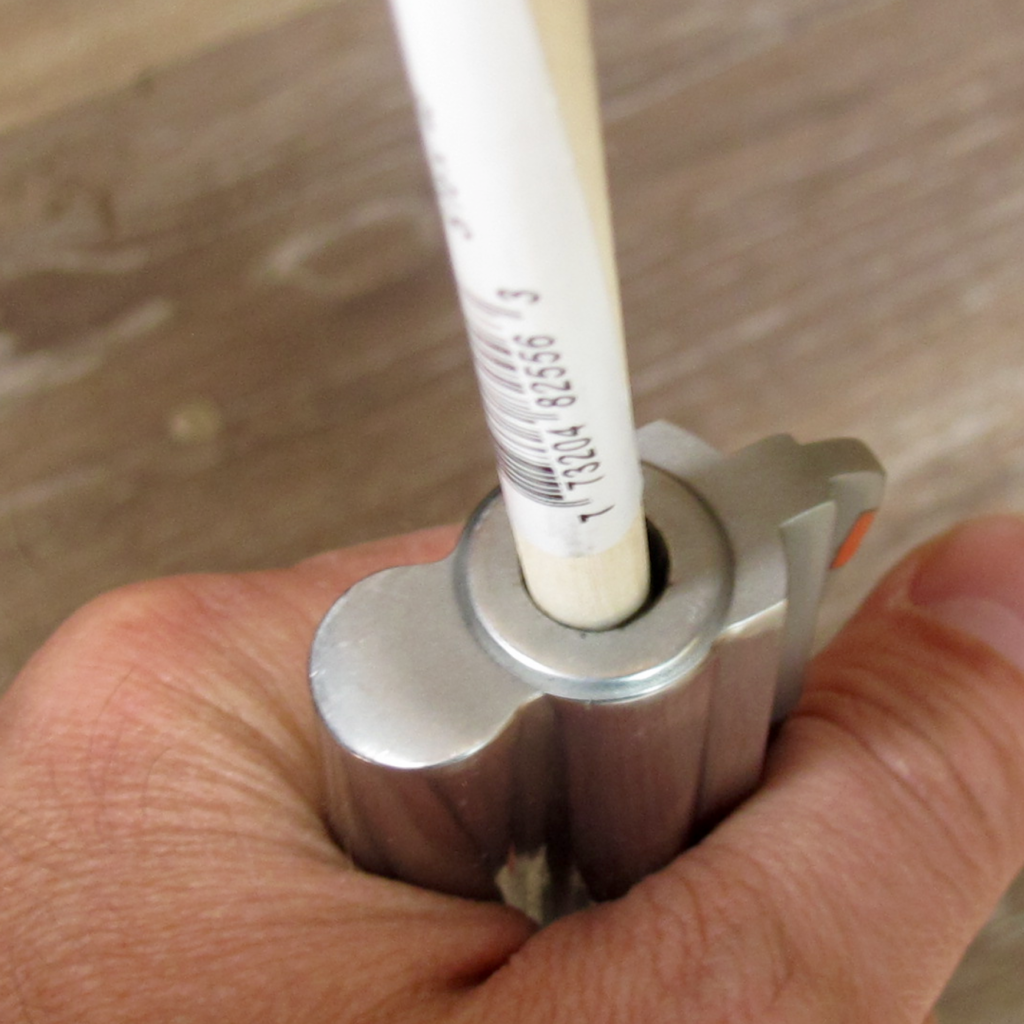
The bullet may take a bit of convincing to come out. In this case, initially breaking the bullet free seemed to be the hardest bit. Once it moved a little it traveled the rest of the barrel length pretty easily.
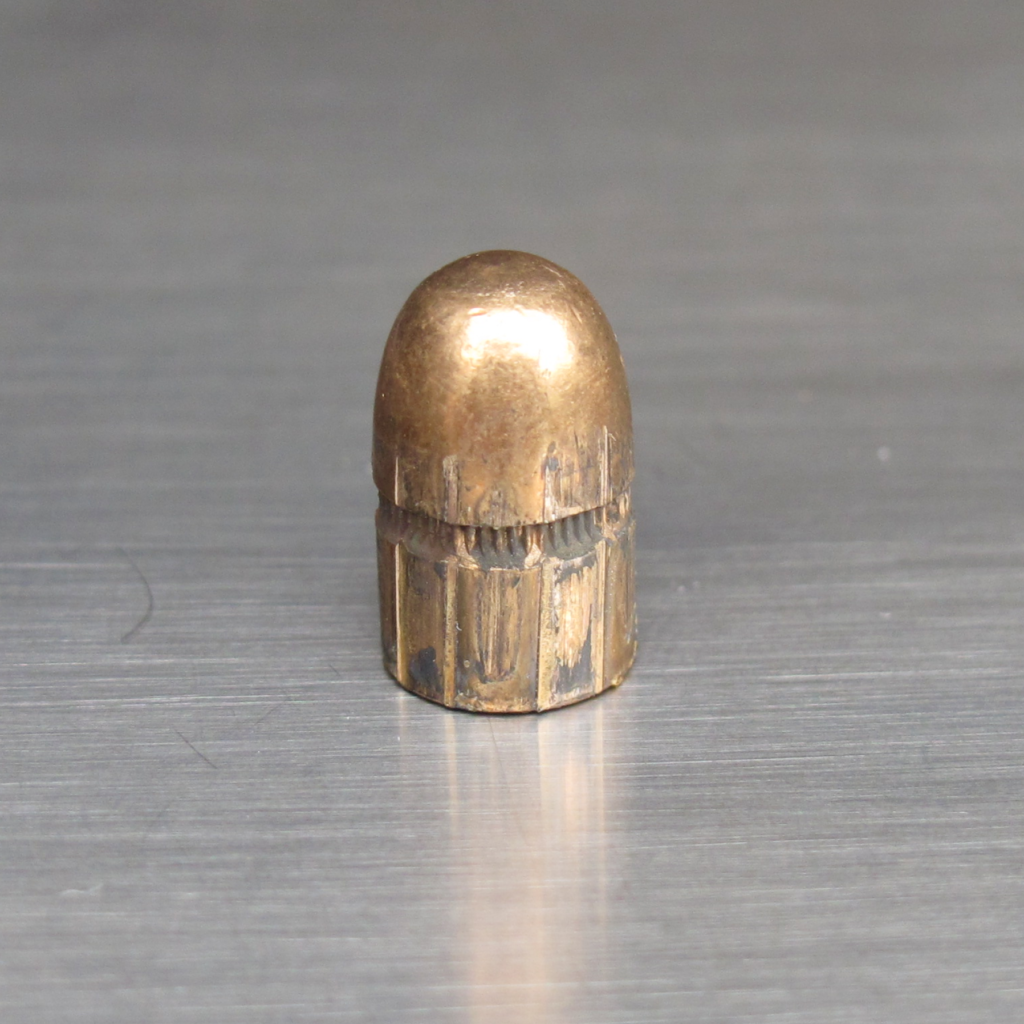
The Bottom Line
The most important advice here is safety: if you experience a squib load with any firearm, CEASE FIRE IMMEDIATELY. If you are a non-firing observer, don’t hesitate to CALL A CEASE FIRE if you seen the indications of a squib load. My friend stated that he will be haunted by his lack of reaction. Honestly, I think he was right behind me and if I hadn’t reacted I’m certain he would have. When in doubt call a cease fire and ensure the barrel is clear before proceeding.
Lucas from the Triangle Tactical Podcast recently recommended keeping a “squib stick” in your range bag. I ignored this advice, and so did my buddy who called us both out at the range. If you shoot a lot – and especially if you shoot handloads – a squib stick can keep an event like this from cutting your range day short. I’m actually kind of glad this happened because I got to experience it in a low-stress, slow-fire situation (and get some photos, too). Without a quick reaction this could have had a very different outcome.

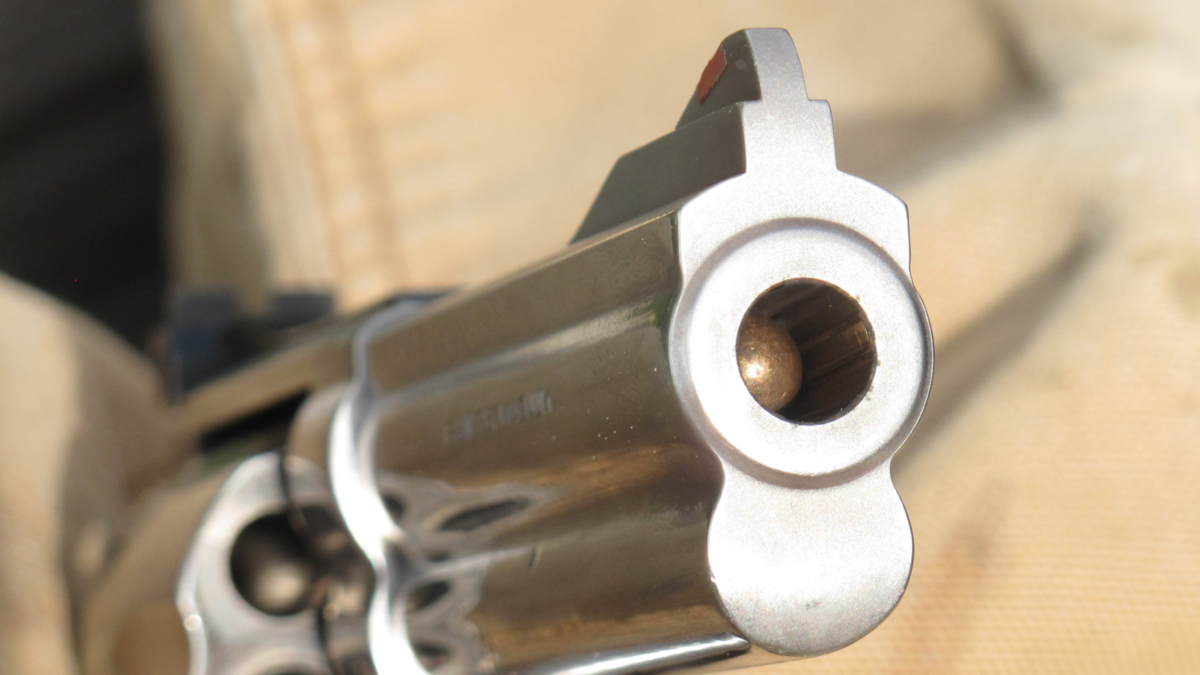
I think you are right; that round probably got wet. The last photo looks like there is really fine mud in the cannelure.
Awesome writeup Justin! Very thorough and right on the money with all recommendations. Great photos, too.
Like you said, a single squib projectile won’t hurt a thing, but a round fired behind it can bulge or (worse yet) burst a barrel. If you happen to be unlucky enough to fire a good round behind the squib, you’ll probably want a pro to clear and check out the gun and give you a verdict on whether or not it’s safe to shoot it again. You might have to rebarrel.
I think you’re exactly right that your powder got contaminated by moisture. However, most of the squibs I’ve seen were the result of loads with no powder in the case–most often handloads, but once with a factory load during the recent ammo crisis, when QC was suffering. If you get a squib (and particularly with handloads) you really need to stop shooting and scrap that whole batch/box of ammo. If necessary, you can pull the bullets and rescue the components, but I wouldn’t shoot any more from that batch/box. If the operator or machine goofed up once, it probably wasn’t the only time.
One serious problem with revolver squibs is when the bullet gets jammed into the forcing cone and stops. This can actually tie up your cylinder, because the bullet may still be partially in the chamber. The cylinder won’t rotate or open up if this happens, and the only way to fix it is to hammer the bullet back into the cylinder far enough that it will clear the frame window and allow you to open the cylinder. This operation must be done very carefully, because there may still be live ammunition in the other chambers, and because the possibility of damaging parts like the yoke or bolt is increased. Again, this may be a job for a pro.
Once again, great work with this. It’s very instructional.
Great write up! I have a squib load story that is true and it was my fault. Shooting a bullseye match in a winter league 10 years ago at the Cincinnati Revolver Club I had a squib load on the fifth shot of a five shot string the 1911 locked back and on command I reloaded for the second string of five. The first shot was let go and a very loud bang followed. No damage to me or the slide but the Clark custom barrel split open and the slide locked on the split open barrel. All I can figure is the lock back action on the fifth shot of the first string masked the feel of a squib load. Both rounds exited the barrel and marked the target in the black at fifty foot! Most bullseye shooters hand load their own ammo which I had done. I was lucky but a costly mistake!
Mike,
That is really a bummer. Although I was more worried about everyone’s safety, I’d have hated to lose my 686 – she would be hard to replace! I hate to hear about your 1911, too! Thanks for sharing.
Justin
Hi Justin,
I have a question. I am new to this topic so please do educate me. You said in the article to check the barrel and try clearing the barrel correct? But isn’t there more risk involved in clearing the barrel from squib load? What if something happens? Isn’t it safer to just ceasefire and take it to a gun smith for repair? Also please advise how exactly can a squib load be avoided 100%? As I am new so have no idea but maintenance of a gun would be one way and making sure bullets are in good condition. Let’s say there is a squib load, and the person decides to put safety on and then inspect the barrel then there is danger correct? Why can’t technology be so advanced to be safe in guns if squib does occur? Some kind of device which safeguards for safety against squib load?
I feel like you might be trolling me, but I’ll bite…
Isn’t it safer to ceasefire and take it to a smith: no. If the gun is clear, it’s clear. If you’re more comfortable taking it to a gunsmith though, by all means feel free.
How can a squib load be avoided 100%: It can be avoided 99.99% by only firing factory new, clean ammo that has been stored properly. Squib loads are an ammo problem, not a gun problem. The only way to avoid it 100% is don’t shoot.
Danger when inspecting the barrel: this can be mitigated 100% by opening and emptying the cylinder, and leaving it open while checking the bore.
Device for squib load safety: the combination of your eyes, ears, and brain.
Another great column! Thanks.
Very interesting writeup, and I’m glad you did everything right and saved a nice gun from destruction (not to mention saving the people involved from injury).
I’ve been shooting revolvers for over 40 years and I’ve never seen a squib load (though I’ve seen quite a few revolvers with bulged barrels from firing the next round). Again, congratulations on recognizing it soon enough to avoid damage and injuries.
I discovered your blog yesterday and I’ve read most of the postings. You do a good job; your facts are right and your writing is entertaining.
Being older than you, I prefer a Model 66 to a 686. It’s lighter, and when you’re as dinged up as I am, weight becomes important.
And did I mention, “Great blog!”?
“…your facts are right…” I can’t think of a higher compliment – thank you!
I like the 66 very much. I’m waiting for the new 2.75″ K-Frame “Combat Magnum” to hit the streets. Sadly I can’t afford the premium on a pre-lock 3″ 66.
Thanks again – it is much appreciated!
Justin
Excellent post on the Squib Load issue, Thanks.
Suggestion:
With bullet removals from barrels that I’ve assisted with, first dripping some gun oil into both ends of the barrel allowed the bullet to be pounded/removed from the barrel with much less effort, than when attempting to do so with a dry barrel.
Awesome advice – I didn’t even think of this. It sounds like some light penetrating oil might work best?
Thanks for the tip!
Justin
The write up is good, the solutions fine. But most squib loads result from hand loaders making a mistake. I have loaded well over 110K rounds in several calibers on Dillon Square Deal B’s and never experienced a squib load. The trick for me is that when something goes wrong in the sequence I remove all complete or partially complete rounds from the progressive press and start a new sequence. While it is possible to figure out where in the sequence each case is, it is safer, and less likely to produce a double charge, or a round with no powder (the prime cause of squib loads) by removing everything and starting again. Pain in the butt yes, safer – definitely.
Jeff, your advice is well taken. I used a Square Deal B and loaded some 38 special loads. I obviously made an error because I had a squib in my Ruger Vaquero today at the range. Not sure why or what happened but it appeared to be a light powder drop. Cleared it with no problem exactly as described above and continued shooting. I have fired well over 100 reloads with no issue until now so it’s obvious that I did something wrong.
only squib I ever got was from fresh factory ammo (straight out of the box). I was shooting a p.o.v when it happened. here is the video. https://youtu.be/Mgo9RQUVQeo
Interesting and timely information. I have been shooting revolvers for more than 40 years, and I had never experienced, nor seen, a squib load. Last February my wife and I were shooting our annual LEOSA qualification course and we experienced “4” squib loads. We were using factory 38 special ammunition from Freedom Munitions. The ammunition was removed from the box immediately before firing, and had never been wet. I returned the remaining ammunition from the case, to the factory, and they provided a refund. There was no explanation provided.
Wow, that sounds like a bad batch for sure! I haven’t used Freedom personally, and now I’m a lot less likely to.
Quite a few years back now, I had my Son & a neighbor teen at the range. About midway into our time, the neighbor kid was shooting my son’s 629 6″. We were shooting some factory loads we bought cheap, just for the brass to reload, as my Son had the only .44 Mag. we had at the time. The brand was PMC. As the day went, it was a good outing until my son’s 629 made a rather muffled disconcerting sound, sort of a thud & poof sound. By the time I got STOP shooting out of my mouth, the neighbor already had the hammer back on the next round !! Luckily, he heard me & just kind of froze in position. I told him to just sit still with the gun pointed downrange, & I got up & proceeded to take the gun from him ! Opening the cylinder was really difficult, & when it did finally swing out, the forcing cone was packed with a kind of dirty yellow dog turd shaped clump that bumped out into my hand !! Yep, looking up the barrel, the bullet was lodged about 1½” up into the 6″ Bbl. I do keep a brass rod, & brass hammer in the range bag, so it was a simple matter to remove the bullet, and the day went on. We later had another cartridge from that same lot that again sounded a little quirky, but no stuck bullet that time. I’ve often wondered what would have happened if I hadn’t gotten him stopped & the next round had been fired !!?? PMC ammo was a hot load when they worked, but we never bought any more of it, & I pulled the bullets on two more boxes from the same lot #, & we reloaded the brass. I even wrote & emailed PMC with the ammo lot # and Manufacture date of the faulty cartriges, but never received a reply or acknowledgement from them, so I guess they didn’t think it was important !!?? I have always been glad I decided to accompany the guys to the range that day, because they often went on their own !!!
I’ve not thought until today to thank you for this post. It helped me fix a problem.
Late in the year I made a dumb mistake while reloading: not zeroing my scale each time. I ended up with light charges (up to half a grain low) and a squib in our Taurus 85. I’d read a bit about them here and elsewhere, so I knew what happened and avoided shooting again, unloaded, and verified a round stuck in the barrel.
I’m not one to panic if I’ve done my homework, so to see if it was a fluke, I shot another round from the same batch through our S&W 64 with the same result! It took a brass rod from Brownells to remove the rounds (now they ride in my range bag), and then I did my penance: unloading 100 rounds of ammo!
Needless to say, I now have TWO scales, a digital and a manual scale. I zero both before loading, then load for a mid-range load so if it’s a bit light, the bullet will still exit the gun. I hope other novice reloaders find and read this post!
I carry a “Squib rod” in my range bag and although it is seldom needed, it can save a range session.
The rod was obtained from Brownells and is about as simple as it gets. It is a length of hard brass rod that is 8″ long. The diameter fits the bore of a 38 Special/357 mag/9mm very closely which insures that it stays centered in the bore. For larger bores you can wrap some black electrical tape around the rod in two places to build up the diameter to the desired diameter.
A Squib rod is the proper tool to remove a bullet stuck in a barrel.
A hardwood dowel is sometimes used to remove stuck bullets but there is a problem with that technique. If the dowel splits at the end in contact with the rounded bullet nose and the wood wedges between the bullet and the barrel – you will find yourself with a problem bigger than the one you started with. If possible, fit an empty casing over the end of the dowel to reinforce the tip of the dowel. A spent 9mm casing will just fit the bore of a 40 S&W barrel.
Another field expedient “Squib rod” is a section of steel threaded rod COVERED with electrical tape to protect the bore. These are readily available in hardware stores and when wrapped with electrical tape, will not damage the barrel.
Great tips! Many thanks.
Squib loads caused by too little or no powder in the case can be identified by weighing each round with a quality digital scale before firing them. The squib load will be several grains lighter than the rest. It only takes a couple minutes to weigh 100 rounds individually. If it is too laborious for range ammo, at least be sure to weigh your self-defence ammo before you call on it to save your life.
Hot tip: spray a little penetrating catalyst like PB or Kroil to assist the bullet coming out. WD-40 or even vegetable oil will help.